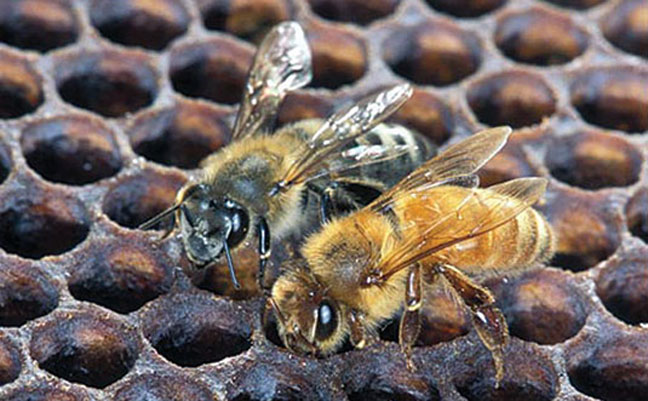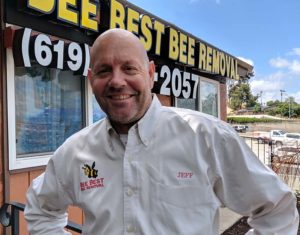
An Africanized honey bee (left) and a European honey bee on honeycomb. Despite color, they normally can’t be identified by eye. Photo: Scott Bauer, USDA Agricultural Research Service, Bugwood.org
Many pest management professionals (PMPs) leave bee removal to experts who have the proper training and equipment.
Jeff Lutz, owner of Bee Best Bee Removal in La Mesa, Calif. is one such expert. The company is licensed by California’s structural pest control board to perform bee eliminations as well as live removal with relocation services.
“If the bee colony is relatively new [a swarm] and able to be swept or placed into a temporary relocation box, we will always prefer to remove the colony live and relocate the bees,” he says. “If the hive is aggressive, hard to reach or inside a structure, we will usually eliminate the bees and open the structure to remove the beehive, if necessary.”
Bee Best Bee Removal has been in business for more than 25 years. Although it is licensed to handle general pest control, it only takes on bee, wasp, yellow jacket and hornet jobs.

Jeff Lutz, owner of Bee Best Bee Removal
“Many of our jobs come from referrals from pest control companies that don’t provide bee services,” Lutz says. “They feel comfortable referring us the jobs, knowing we won’t try to steal their accounts because we don’t have any pest control routes. Also, many companies give us referrals for the difficult jobs they don’t want to take on, usually jobs that are at or above two stories high.”
Live removal criteria
But not all jobs are suitable candidates for live removal with relocation, he says. He and his team take several factors into consideration before agreeing to remove the bees alive. They are:
- The temperament of the colony. The bees in San Diego, where Bee Best Bee Removal is based, and the southern United States in general, are partially Africanized to various degrees. Some swarms are sweet and gentle, whereas others are extremely aggressive and defensive. Most are somewhere in between the two extremes. If the bees are aggressive, it is not always safe to perform a live removal, especially if the colony is near a sensitive site like a school or a hospital.
- The age of the hive or swarm. In general, the larger and more established the hive, the more aggressively the members of the colony will defend it. New bee problems, or swarms, which have not built a hive yet are usually more docile and make better candidates for live removal.
- The location of the How hard is it to get to the colony? Is the hive hanging off a limb on a tree that is easy to reach? Can the bees be easily placed in a temporary relocation box and transferred to an apiary? Or are the bees 40 feet up in a tree? The harder the colony is to reach, the more difficult it will be to wrangle bees into a box. Bees that require tall ladders usually are not a good candidate for live removal due to the liability and the difficulties associated with working with live bees off a tall ladder.
- Where the bees are inside a structure. Are they in a tile roof? A stucco wall? Under a shed floor? Although some companies will open structures with a live beehive inside, they usually are not licensed with the state’s structural pest control board or they are in a part of the country where Africanized bees are not an issue. Taking a power tool — like a saw, chipper or electric drill — and powering it up next to a fully established bee hive carries an incredible amount of liability. Saving bees is important, but human safety comes first. “We value our license with the pest control board and do not want to take a risky live removal job that would put our license in jeopardy,” he says.
- Whether the job is possible to perform live. Bees that are inside a light pole, in a block wall, and/or underneath concrete are sometimes impossible to remove alive. “By the time you open a block wall, for example, the hive usually will be crushed by the demolition process of gaining access to the beehive,” Lutz says.
Live relocation factors
Bee Best Bee Removal networks with other bee removal companies and members of the local beekeeping society.
“The companies and beekeepers we work with must be dedicated to humane and sustainable beekeeping,” Lutz explains. “We do not give swarms to just anyone.”
He says his company provides bees only to those who have:
- Experience handling bees.
- A bee suit, hive tools and a beehive box.
- Adequate land on which to put the bees.
- Membership with the local beekeeping society.
In addition, they must sign a release of liability when receiving the bees and agree to best management practices with regards to safe beekeeping.
“Because we have feral Africanized bees in our county, the signed agreement includes a clause that they will requeen the hive to reduce the aggression of the colony,” Lutz says.
Bee removal myths
“Rumor, myths, and political agendas have caused considerable confusion with many things bee-related,” Lutz says. Here, he shares some of the most common misconceptions regarding bee removal:
Myth 1: Bee removal is free. There is a myth that bees are so rare and valuable that there are people who will go out and provide bee removal service for free. In reality, it is incredibly rare to find anyone who would be willing to go out, spend their time, gas, money and energy to remove a bee problem off someone else’s property, says Lutz. “This myth is further exploited when online marketers like Yelp use ‘click bait’ advertisements for free bee removal,” he explains. “The reality is, none of the companies Yelp lists offer free bee removal services. The ad deceptively drives traffic to the Yelp website by tricking people into clicking for a free bee removal service.” Once they land on the Yelp website, Lutz adds, they call the companies listed and are usually upset to find that all of them charge for their service.
Myth 2: It is illegal to kill bees. “Believe it or not, this myth is sometimes perpetuated by licensed pest control companies, usually by companies that do not offer bee services,” Lutz says. He adds that although there are issues with bee loss and shortages in various states, it is a myth that bees are endangered. In fact, feral honeybees are not on the endangered species list. If someone has a swarm or hive on their property, it is legal to resolve the problem via live removal, and/or elimination. So, when is it illegal to kill bees? If someone only has bees that are foraging, pollenating, and/or scouting, then it is illegal to spray for bees, he says. In other words, it is illegal to kill bees when no hive or swarm is present.
Myth 3: Live bee removal is always humane bee removal. “Live removal” can mean may things. Some companies advertise live removal because technically the bees are removed alive without the use of pesticides. The fact is, there often is a big difference between live removal vs. live removal with humane relocation of the bees. Many unlicensed companies offer incredibly cheap service and deceive customers into believing the bees will be saved. In reality, these companies will sometimes kill the bees by secretly spraying or dumping the bees once they are removed from the property. True humane bee removal takes an incredible amount of knowledge, time, money, and resources to save the bees. The less a company charges for bee removal, the more likely that the bees are not actually being relocated and tended to humanely.
For PMPs seeking additional information on bee removal, training is available.
“The best training will likely come from working with an experienced bee removal professional and/or company,” Lutz says. “Other sources of training usually can be found with a local beekeeping society.”
Your state’s Department of Agriculture is another good resource for beekeepers in your area.
Featured photo: Scott Bauer, USDA Agricultural Research Service, Bugwood.org
Thanks for sharing this post about bees. I feel it is always best to call in a professional to get good advice on how to deal with pest control problems. http://www.exterminatorsedmonton.com/
Great information, thank you.